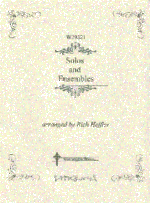-
I Know Whom I Have Believed
$9.95This setting is lighthearted, and reminiscent of the style of Scott Joplin.
-
Fairest Lord Jesus/I Surrender
$6.95Advanced classical style. Slow movement with ornamentation characteristics typical of the Classical period.
-
Open My Eyes
$6.95This arrangement uses some authentic Brahms material from the 2nd Symphony. Beautiful lines.
-
-
-
All Hail The Power
$6.95Here is the timeless “Diadem” hymntune in a Beethoven-like setting. (ww, str. Piano)
-
-
-
Open My Eyes
$5.50Combined with music from Brahms Second Symphony in the opening. The second section is more straight-forward of the tune itself where it moves to the thematic material of Brahms once again. The coda section is tranquil where it comes to a final rest.
-
It Is Well With My Soul
$5.50Traditional setting, slightly contemporary- begins with piano in a motif of the theme. The first section is a stylized rendition of the theme. Then, it continues in the chorus much the same. A transition becomes freer in rhythm and harmony. It then repeats back to the opening sections and then moves to the coda where the piece ends in a solemn fashion.
-
-
-
-
There Is A Fountain
$5.50A Rich Heffler Music arrangement. The solo begins in a plaintive manner with light embellishment modulating upward in key to a more florid rendition of the melody. The final section goes back to the original key and continues onward in a florid manner.
-
Open My Eyes
$5.50Combined with music from Brahms Second Symphony in the opening. The second section is more straight-forward of the tune itself where it moves to the thematic material of Brahms once again. The coda section is tranquil where it comes to a final rest.
-
It Is Well With My Soul
$5.50Traditional setting, slightly contemporary- begins with piano in a motif of the theme. The first section is a stylized rendition of the theme. Then, it continues in the chorus much the same. A transition becomes freer in rhythm and harmony. It then repeats back to the opening sections and then moves to the coda where the piece ends in a solemn fashion.
-
-
-
-
-
O God, Our Help….Passacaglia /Fugue
$5.50Written in typical passacaglia (theme in the bass line) and Fugue fashion, the theme is presented in the piano. The first variation is a gently modified tune in duple with the accompaniment in triplets. In variation two, the tune is rhythmically altered while the upper accompaniment is presented in a spritely fashion. Variation three, the tune is in a triplet moving nature while the theme is in block harmonization in the accompaniment. Variation four is expressive in an almost cadenza fashion. Finally, the Fugue is in a lively four voice manner, ending with a strong proclamation of the title, itself.
-
-
Leaning On The Everlasting Arms
$5.50This solo begins with a easy lilt underpinned by a gentle accompaniment. Moving into the second section of the piece the tune is embellished in a variation format of chromatic triplets. It repeats back to the first section and proceeds to a Coda section- again, in a triplet format.
-
-
Open My Eyes
$5.50Combined with music from Brahms Second Symphony in the opening. The second section is more straight-forward of the tune itself where it moves to the thematic material of Brahms once again. The coda section is tranquil where it comes to a final rest.

